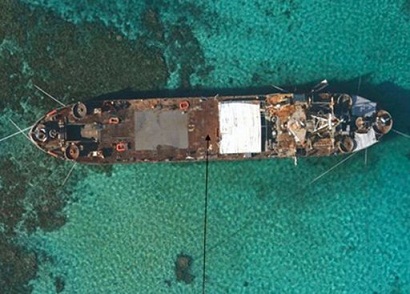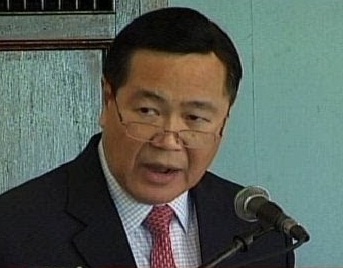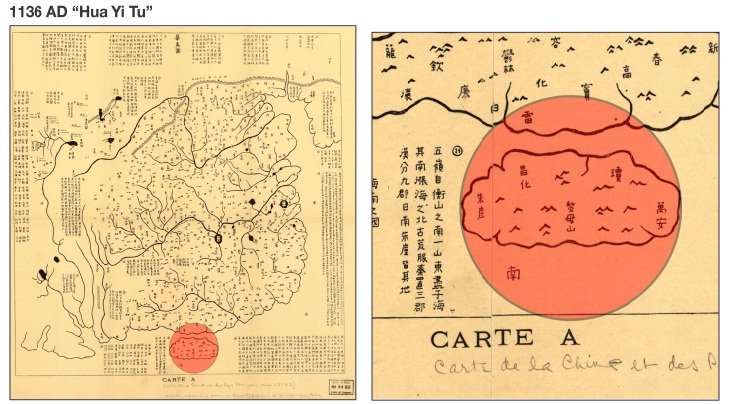
BRP Sierra Madre stuck in Ayungin Shoal, 25 miles from Mischief Reef occupied by the Chinese.
Here we go again. This time it’s over Ayungin Reef (Ren’ai Reef to the Chinese.)
The Philippine Navy reported sightings of Chinese ships in the vicinity of Ayungin shoal as early as first week of May, the last stretch of the May 13 elections, and before the May 9 incident in Balintang Channel where the Philippine Coast Guard fired upon a Taiwanese fishing vessel and killed one of the fishermen.
The Department of Foreign Affairs filed a diplomatic protest on Chinese presence near Ayungin shoal May 10.
DFA Spokesman Raul Hernandez said in their protest, they cited “the provocative and illegal presence of the Chinese government ships around Ayungin Shoal.”
He said that “Ayungin Shoal is an integral part of our national territory” stressing that shoal is located 105.77 nautical miles from Palawan and constitutes part of the country’s 200-nautical mile continental shelf as provided under the United Nations Convention on the Law of the Sea.
China, of course, insisted that Ayungin Reef, which they call Ren ‘ai Reef, is theirs being a part of Sansha City, established last June in the southernmost province of Hainan. The Philippines had also protested the inclusion of Macclesfield Field, one of the largest underwater atolls in the world, covering an area of 6,500 square kilometers which is in Philippine territory, under Sansha city.
An article in a Chinese online publication, Global Times, under the headline, “Ren’ai Reef under actual control of China” said, “ Wang Xiaopeng, a scholar studying issues pertinent to territorial seas at China’s Academy of Social Sciences, commented that the Chinese Foreign Ministry never made mention of the Ren’ai Reef when, back in April, it released eight Chinese islets and reefs currently seized by the Philippines, which means the Ren’ai Reef is already under China’s actual control.”
The eight islets that the Chinese acknowledged being occupied by the Philippines are Lawak, Patag, Parola,Pag-asa,Kota, Panata,Rizal, Likas.
The article further said:“Ren’ai Reef… is part of the Chinese territory and, an area over which China proclaims sovereignty and vows never to yield an inch to others. “
Obviously, China ignores the fact that in Ayungin shoal, there’s BRP Sierra Madre, a Philippine Navy ship that was purposely beached in the islets following the occupation by China of the Mischief or Panganiban Reef in 1994. Ayungin Reef is 25 miles away from Mischief Reef.
What does the Philippine government do in the face of what many fear is another expansionist act by China in the disputed waters of Spratlys.
Not much really. The Philippines has filed a petition with the United Nations’ Artbitral Court to look, among other issues, into the legality of China’s nine-dash line map,which is the basis for its claim of the whole South China Sea including islands in the territorial waters and exclusive economic zones of the Philippines, Vietnam, Malaysia, Brunei and Vietnam.
But the petition has not deterred China from going into disputed areas they consider part of their territory.
Supreme Court Justice Antonio Carpio, in his speech before the graduating class Pamantasan ng Lungsod ng Maynila College of Law last week, warned of the dangers of China’s 9-dashed line.
“In the case of the Philippines, China’s 9-dashed line claim takes away our exclusive economic zone and extended continental shelf in the West Philippine Sea beyond 30 to 50 NM from the baselines of the Philippines. That deprives the Philippines of 80% of its exclusive economic zone, and 100% of its extended continental shelf, in the West Philippine Sea.”
But even Carpio acknowledges the difficulty of enforcing the decision of the U.N Arbitral Court if it’s adverse to China, which has refused to participate in the case.
“So what can the Philippines do?,” Justice Carpio asked.
Carpio said “The only remaining recourse for the Philippines is to appeal to world opinion.”
He told the graduates: “As life-long students of the law with an abiding faith in the Rule of Law, it is your mission from now on to help shape world opinion that a nation should follow the Rule of Law if it wants to be accepted as a member and leader of the community of civilized nations. If a nation refuses to comply with the Rule of Law, then it becomes a rogue nation, an outcast in the community of civilized nations where adherence to the Rule of Law is the norm. A nation that aspires to be a world power but refuses to follow the Rule of Law is a danger to peace and stability in our world.”
Carpio said a favorable decision from the arbitral tribunal, and world opinion also in our favor, time will be on the side of the Philippines.
“In matters of sovereign rights among nations, our time horizon should span several decades or even longer. In the battle to defend a nation’s sovereign rights from encroachment by other states, there is no such thing as instant success. Even nations with the Rule of Law and world opinion on their side must persevere for a very long time to succeed,” he said.


